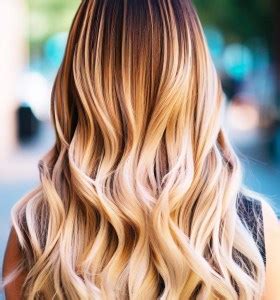Introduction
In the realm of hair coloring, the battle between balayage and highlights has been raging on for years. Both techniques create stunning hair transformations, but they differ in their approach, results, and maintenance. This comprehensive guide will delve into the intricacies of balayage and highlights, helping you make an informed decision about the perfect hair coloring technique for your needs.

What is Balayage?
Balayage is a freehand hair coloring technique that creates a natural, sun-kissed look. It involves painting color onto selected sections of hair to blend seamlessly with your natural base color. Balayage creates a soft, dimensional effect that mimics the natural lightening caused by the sun.
Advantages of Balayage
- Natural-looking results: Balayage blends color subtly, creating a sun-kissed, effortless look.
- Versatile: Suitable for all hair textures and lengths, from short bobs to long locks.
- Low maintenance: Balayage grows out seamlessly, reducing the need for frequent touch-ups.
- Corrects color mistakes: Balayage can help blend away unwanted tones or cover up roots.
What is Highlighting?
Highlighting involves the strategic placement of foils or caps to isolate sections of hair for color application. The isolated hair is then lightened to create contrasting streaks or highlights. Highlights can be subtle or bold, depending on the desired effect.
Advantages of Highlights
- Subtle or dramatic effects: Highlights allow for a wide range of looks, from soft, natural-looking streaks to bold, statement-making contrasts.
- Enhances texture: Highlights can add depth and dimension to flat or fine hair, making it appear fuller and healthier.
- Versatile: Suitable for all hair types, but especially beneficial for dark hair or hair with uneven color distribution.
- Low maintenance: Highlights require touch-ups only every few months to maintain their vibrancy.
Balayage vs Highlights: A Comparison
| Feature | Balayage | Highlights |
|---|---|---|
| Technique | Freehand painting | Foils or caps |
| Results | Natural, sun-kissed | Contrasting streaks |
| Maintenance | Low, seamless growth | Requires touch-ups |
| Versatility | Suitable for all hair types | Ideal for dark hair or uneven color distribution |
Which Technique is Right for You?
The choice between balayage and highlights depends on your desired look, hair type, and lifestyle. Consider the following factors:
- Desired effect: Balayage is ideal for a natural, lived-in look, while highlights offer bolder, more dramatic effects.
- Hair type: Balayage works well on all hair textures, while highlights may be better suited for dark or fine hair.
- Maintenance: Balayage is low-maintenance, while highlights require touch-ups every few months.
- Lifestyle: Balayage is a great option for busy individuals who want a low-maintenance hair color, while highlights may be more suitable for those who enjoy regular salon visits for touch-ups.
Tips for Choosing the Perfect Technique
- Consult with an experienced hair stylist to determine the best technique for your hair type and desired look.
- Bring inspiration photos to your appointment to communicate your vision clearly.
- Consider your skin tone and eye color when choosing shades for balayage or highlights.
- Opt for high-quality hair color products to minimize damage and ensure long-lasting results.
Common Mistakes to Avoid
- Overlapping: Avoid painting balayage too close together, as it can create unnatural lines.
- Underexposing highlights: Ensure that foils or caps are applied correctly to prevent uneven or brassy results.
- Using too much bleach: Be cautious when using bleach for highlights, as it can damage hair if overused.
- Ignoring maintenance: Both balayage and highlights require proper maintenance to keep hair healthy and vibrant.
FAQs
1. How often should I get balayage or highlights touched up?
- Balayage: Every 12-18 months
- Highlights: Every 6-8 weeks
2. Can I do balayage or highlights at home?
- It is not recommended to attempt balayage or highlights at home without professional training.
3. Will balayage or highlights damage my hair?
- Both techniques involve chemical processing, which can potentially damage hair if not done correctly.
4. How can I extend the lifespan of my balayage or highlights?
- Use color-safe shampoos and conditioners
- Limit heat styling
- Avoid chlorine and saltwater exposure
5. What are the latest trends in balayage and highlights?
- Root smudging: Blending the roots with a darker shade to create a soft, graduated effect.
- Splashlighting: Adding vibrant pops of color to specific sections of hair.
- Ecaille: A tortoiseshell-inspired technique that creates warm, dimensional results.
6. What are some unique applications for balayage and highlights?
- Corrective color: Balayage or highlights can be used to blend away unwanted tones or cover up roots.
- Face framing: Highlighting or balayaging the front sections of hair to brighten the complexion.
- Ombré: Creating a gradual transition from dark roots to lighter ends.
Conclusion
Whether you prefer the natural, sun-kissed look of balayage or the bold, contrasting effect of highlights, choosing the right hair coloring technique is essential for achieving your desired transformation. By understanding the differences between these techniques, considering your individual needs, and following proper maintenance practices, you can maintain healthy, vibrant hair that effortlessly enhances your style.
